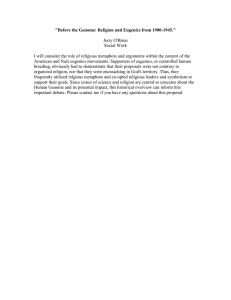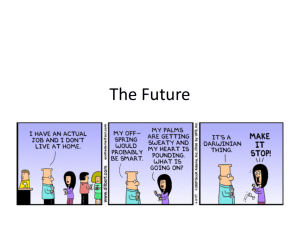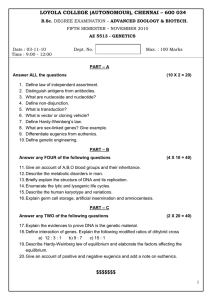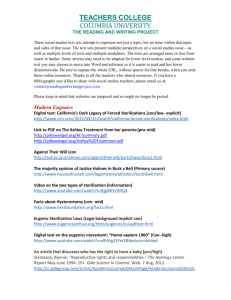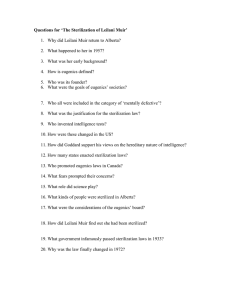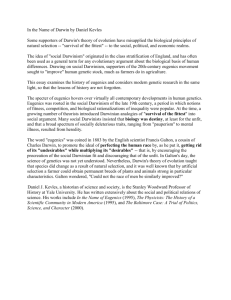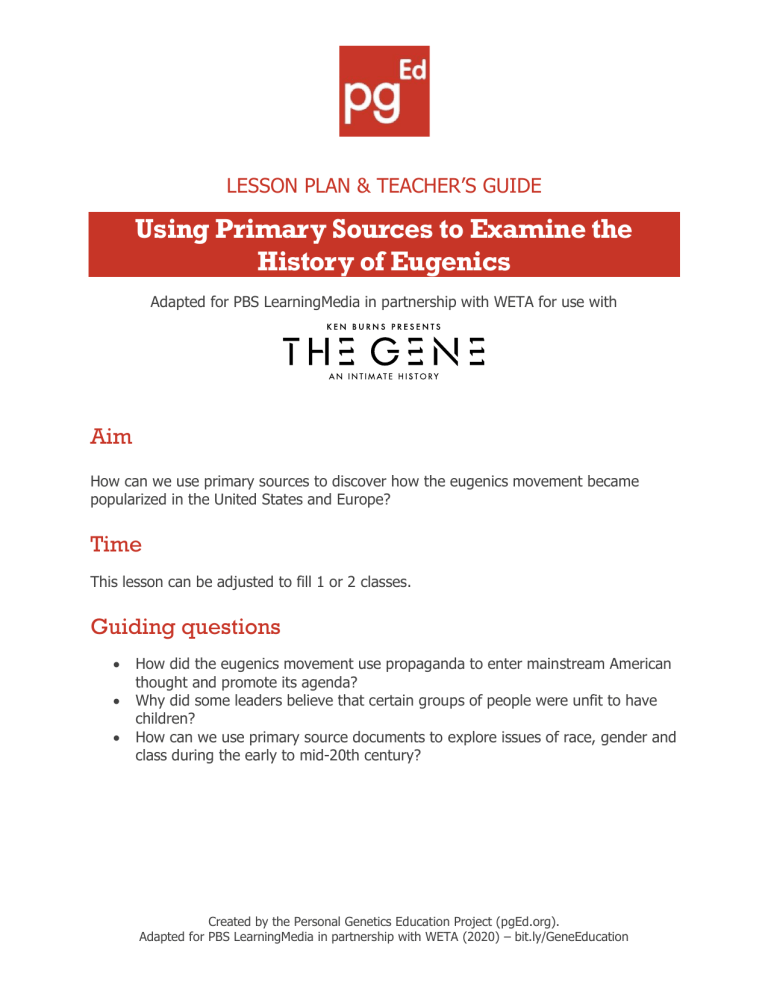
LESSON PLAN & TEACHER’S GUIDE Using Primary Sources to Examine the History of Eugenics Adapted for PBS LearningMedia in partnership with WETA for use with Aim How can we use primary sources to discover how the eugenics movement became popularized in the United States and Europe? Time This lesson can be adjusted to fill 1 or 2 classes. Guiding questions • • • How did the eugenics movement use propaganda to enter mainstream American thought and promote its agenda? Why did some leaders believe that certain groups of people were unfit to have children? How can we use primary source documents to explore issues of race, gender and class during the early to mid-20th century? Created by the Personal Genetics Education Project (pgEd.org). Adapted for PBS LearningMedia in partnership with WETA (2020) – bit.ly/GeneEducation Learning objectives By the end of the lesson, students will be able to: • • • Analyze original images and documents from the American eugenics movement Discuss how genetics can be used to enhance peoples’ lives and ways to prevent it from being used as a new form of eugenics. Make connections between the American Eugenics Movement and other historical events, such as the Nazi regime in Germany during World War II. Materials Handouts, laptop, projector or SMART board. Standards alignment Common Core Standards CCSS.ELA-LITERACY.RST.9-10.2 Determine the central ideas or conclusions of a text; trace the text’s explanation or depiction of a complex process, phenomenon, or concept; provide an accurate summary of the text. CCSS.ELA-LITERACY.RH.9-10.2 Determine the central ideas or information of a primary or secondary source; provide an accurate summary of how key events or ideas develop over the course of the text. CCSS.ELA-LITERACY.RH.9-10.3 Analyze in detail a series of events described in a text; determine whether earlier events caused later ones or simply preceded them. CCSS.ELA-LITERACY.RH.9-10.4 Determine the meaning of words and phrases as they are used in a text, including vocabulary describing political, social, or economic aspects of history/social science. CCSS.ELA-LITERACY.RH.9-10.9 Compare and contrast treatments of the same topic in several primary and secondary sources. Next Generation Science Standards This pgEd lesson integrates some of the NGSS practices and cross cutting concepts associated with the following disciplinary core ideas. The relevant portion of each disciplinary core idea is written out below. HS-LS3: Inheritance and Variation of Traits LS3.B: Variation of Traits • Environmental factors also affect expression of traits, and hence affect the probability of occurrences of traits in a population. Thus the variation and distribution of traits observed depends on both genetic and environmental factors. Created by the Personal Genetics Education Project (pgEd.org). Adapted for PBS LearningMedia in partnership with WETA (2020) – bit.ly/GeneEducation 2 Background information and note to teachers New genetic technologies are allowing us to assess and alter our own DNA and the world around us. With it comes excitement about the potential for treating disease, as well as fears that some applications (such as embryo screening, prenatal testing of fetal DNA, and genome editing) could lead to a new era of eugenics. This lesson, in combination with our lesson “Genetics, History and the American Eugenics Movement”, introduces the term “eugenics” and provides a foundation of historical knowledge about the eugenics movement that began in the United States in the early 20th century. The goal is for students to develop a more informed lens for discussing the benefits and implications of genetic technologies that are emerging today. Eugenics is the philosophy and social movement that argues it is possible to improve the human race and society by encouraging reproduction by people or populations with “desirable” traits (termed “positive” eugenics) and discouraging reproduction by people with “undesirable” qualities (termed “negative” eugenics). Eugenic ideas about the value of different social classes have been used to justify discrimination, slavery, and genocide around the world for hundreds, if not thousands, of years. In the early 20th century, as geneticists began to widely recognize the basic principles of inheritance (discovered by Gregor Mendel decades before), the science of modern genetics played a significant role in advancing the arguments in favor of government policies in the United States prohibiting interracial marriage, restricting immigration, and sterilizing individuals against their will or without their knowledge. The scientific arguments were flawed from the beginning yet took root and grew. This history, known as the American eugenics movement, was supported and encouraged by a wide swath of people, including everyday citizens, politicians, scientists, social reformers, prominent business leaders, and influential individuals who shared a goal of reducing the “burden” on society. Eugenicists argued that parents from “good stock” produced healthier and intellectually superior children. They believed that “traits” such as poverty, shiftlessness, criminality and poor work ethic were inherited, and that people of Nordic ancestry were inherently superior to other peoples, despite an obvious lack of evidence and scientific proof. In the early 20th century, not all scientists were supportive of the scientific underpinnings of eugenics. However, eugenicists were able to persuade the Carnegie Institution and prestigious universities to support their work, thus legitimizing it and creating the perception that their philosophy was, in fact, science. The eugenics movement became widely seen as a legitimate way to improve society and was supported by people such as Winston Churchill, Margaret Sanger, Theodore Roosevelt and John Harvey Kellogg (of Kellogg’s cereal). Eugenics became an academic discipline at many prominent colleges, including Harvard University. From the outset, the movement also had critics, including lawyer and civil rights advocate Clarence Created by the Personal Genetics Education Project (pgEd.org). Adapted for PBS LearningMedia in partnership with WETA (2020) – bit.ly/GeneEducation 3 Darrow as well as scientists who refuted the idea that “purity” leads to fewer negative gene mutations. Nevertheless, the United States became the first country to have a systematic program for performing sterilizations on individuals without their knowledge or against their will. The majority of people targeted for sterilization were deemed of inferior intelligence, particularly poor people and eventually people of color. 1 Between 1927 and the 1970s, there were more than 60,000 compulsory sterilizations performed in 33 states in the United States; California led the nation with over 20,000. Experts think many more sterilizations were likely performed, but not officially recorded.2 Adolf Hitler based some of his early ideas about eugenics on the programs practiced in the United States. He became its most infamous practitioner; the Nazis killed tens of thousands of people with disabilities and sterilized hundreds of thousands deemed inferior and medically unfit during the Holocaust. In the Holocaust, 6 million Jewish people were murdered, as well as many other millions of people who were targeted for their political beliefs, ethnicity, sexual orientation, and religious beliefs. These include people of Slavic descent (e.g., Poles, Russians, Ukrainians), Romani people, members of the LGBT community, people that were considered mentally or physically disabled, people with opposing political views (including prisoners of war), Christians, Muslims, people of color, and many others deemed “undesirable” by the Nazi regime. After World War II and the Holocaust, the American eugenics movement was widely condemned. However, sterilization programs continued in many states until the mid1970s. In California, researchers are bringing lost histories from this era to light and have uncovered evidence that certain groups of people, including people of African, Indigenous, and Latinx ancestry, were victimized at rates higher than other groups. For more, see “On a Eugenics Registry: A Record of California’s Thousands of Sterilizations” from NPR. This lesson looks at the history of the American eugenics movement to inform the conversation about how society can reap the benefits of new genetic tools, while safeguarding against future misuse. Examining historical injustices is not meant to dissuade people from taking advantage of potentially life-saving genetic technologies. Black, Edwin, War Against the Weak: Eugenics and America’s Campaign to Create a Master Race (Dialog Press, 2003). 1 Stern, Alexandra Minna, Eugenic Nation: Faults and Frontiers of Better Breeding in Modern America (Berkeley, University of California Press, 2005), p. 84. 2 Created by the Personal Genetics Education Project (pgEd.org). Adapted for PBS LearningMedia in partnership with WETA (2020) – bit.ly/GeneEducation 4 Rather, the goal is that people are aware of the possibilities and better equipped to evaluate the benefits and risks of genetic technologies. The goal of this lesson is for students to assess and discuss historical documents to deepen their understanding of eugenics and learn from their peers via the classroom activity. pgEd’s companion lesson, “Genetics, History and the American Eugenics Movement”, gives students the chance to engage in conversations that contrast the dangers of eugenics with the benefits that can come from genetic information and technology. Students will have a chance to debate and discuss the content of these lessons, even though complete consensus about the intersection of genetics and society will be difficult. Outline of resources and activities in this lesson 1. 2. 3. 4. 5. Part 1 – Overview for students (page 6) Part 2 – Classroom activity (page 7) Part 3 – Notes for primary sources (pages 8-11) Part 4 – Handouts & Assessments (page 12) Additional Resources & Related Lessons (page 15) Activities This lesson asks students to view a clip from The Gene: An Intimate History (10 minutes), analyze a primary source document (10-20 minutes) and participate in class presentations and discussion (20-30 minutes). Many of the images in the video and document analysis activity are shocking and could be disturbing to students. These topics may be personal for students as they reflect on their own families and how they may have been affected by these events. Teachers may consider making students aware of this ahead of time and offer breaks or writing/reflection opportunities throughout the lesson. Created by the Personal Genetics Education Project (pgEd.org). Adapted for PBS LearningMedia in partnership with WETA (2020) – bit.ly/GeneEducation 5 Using Primary Sources to Examine the History of Eugenics Part 1: OVERVIEW FOR STUDENTS Vocabulary: There are several vocabulary words with which students may be unfamiliar. You can provide a vocabulary list, or have students look up words themselves. Eugenics – The social movement to “improve” society by encouraging or discouraging people to have babies. Eugenics promoted reproduction by people or groups with “positive” qualities and discouraged or sometimes stopped reproduction by groups with “negative” qualities. Holocaust – The state-sponsored persecution and mass murder of millions of Jewish people, as well as others targeted for their political beliefs, ethnicity, sexual orientation, and religious beliefs, by the German Nazi regime between 1933 and 1945. Pedigree chart – A diagram that shows the occurrence and appearance of phenotypes (physical traits) of a particular organism and its ancestors from one generation to the next. Sterilization – The prevention of a person from reproducing. Sterilization was a key tool of eugenics. Video clip from The Gene: An Intimate History (10 minutes): We recommend beginning this lesson by showing students the accompanying clip from The Gene: An Intimate History to briefly introduce the history of the American eugenics movement. If you have additional class time to devote to this topic, you may also choose to start with pgEd's companion lesson, Genetics, History and the American Eugenics Movement that delves deeper into this history and asks students to consider how society can take advantage of the promise of genetics, while avoiding the mistakes of the past. Created by the Personal Genetics Education Project (pgEd.org). Adapted for PBS LearningMedia in partnership with WETA (2020) – bit.ly/GeneEducation 6 Using Primary Sources to Examine the History of Eugenics Part 2: CLASSROOM ACTIVITY Analyzing Primary Sources (10-20 minutes): Students will break into groups of 2 or 3 to analyze primary source documents and images related to the eugenics movement; the accompanying Printable document contains the primary source materials. The students will answer questions about the document or image they have received. a) Give each group a handout of one written document or image from the accompanying Printable document. b) Distribute either the Written Document Worksheet or Image Analysis Worksheet. Students will examine the document or image and answer the questions to analyze and interpret its meaning. The worksheets are the assessment for the lesson and should be collected by the teacher. Group Presentations (20–30 minutes): Groups will present their document or image analysis to the class. Have students explain the main idea or meaning of their primary source and what it tells them about the eugenics movement and/or US society at the time. Use the PowerPoint slides to project the images to the class as the groups present. For an additional assessment, class presentations and the group discussions can be used as the basis for writing a reflective essay. Created by the Personal Genetics Education Project (pgEd.org). Adapted for PBS LearningMedia in partnership with WETA (2020) – bit.ly/GeneEducation 7 Using Primary Sources to Examine the History of Eugenics Part 3: NOTES FOR PRIMARY SOURCES The slide notes below are intended as information for the teacher, as they help students to understand the document or image and ensure that students' interpretations are correct. Do not hand out the information to students, as they should be analyzing the information using the primary source. Primary sources notes Slide 2 This display is from a Midwestern state fair in the Unites States in the 1920s. Large posters and displays about genetics became common at state fairs during this time, where there was often information about genetics related to animal breeding. The display highlights the idea that people with genetic disorders, or with perceived genetic “weaknesses”, were a burden to society. It also promoted the idea that there were people born of “inferior” or “superior” stock. Part of the goal was to promote parents of “good stock” to have large families. Slide 3 The image on the left, from a state fair, is of a “Better Baby Contest”. The contests began as a way to promote health in children and to educate parents about taking care of babies and young children. As the events evolved, children were judged on various categories related to mental and physical development. Criteria could range from height to behavior to stubbiness of fingers. The image on the right is of a prize metal awarded in such a contest. You can learn more here. Slide 4 This pamphlet for the Kansas Free Fair was produced in 1929 by the American Eugenics Society, which promoted “racial betterment” and eugenic health. The goal of such a pamphlet was to encourage eugenic marriage and mate selection. It also provides insight into some of the misconceptions of eugenicists, including the belief that traits such as feeblemindedness, criminality, and pauperism were inherited traits. Created by the Personal Genetics Education Project (pgEd.org). Adapted for PBS LearningMedia in partnership with WETA (2020) – bit.ly/GeneEducation 8 Slide 5 Published in Germany in 1936, this poster is part of a larger exhibition on race. The goal was to promote “positive” eugenics, encouraging healthy people to reproduce and have large families, under the mistaken assumption that healthy people did not have children with genetic disorders or heritable diseases. This particular poster promotes sterilization in order to prevent the birth of disabled children. Slide 6 Women were deemed “feeble-minded” and “promiscuous” for a variety of reasons. “Feeblemindedness” was a vague and wide-ranging designation of people being committed to mental institutions. It included women who gave birth out of wedlock, even if they were victims of rape, and women and girls who were deemed promiscuous and dangerous to the general population. This document showcases the ways in which gender and women’s lack of social and political power at the time were used to designate particular people for sterilization. Slide 7 Written by Justice Oliver Wendell Holmes, Jr., the 1927 Supreme Court Ruling Buck v. Bell, allowed forced sterilization by government agencies such as public health departments. Carrie Buck was the plaintiff in the case. This case established that the state has the right to force a person to be sterilized without his or her consent. While many cases have criticized this ruling, technically, the decision has never been overturned. Carrie Buck was born to a poor mother who was eventually committed to the Virginia State Colony for Epileptics and the Feebleminded, at which time Carrie was placed in foster care. At the age of 17, Carrie became pregnant as the result of a rape, most likely by the nephew of her foster parents. Her foster parents then committed her to the Virginia State Colony on the grounds of feeblemindedness, promiscuity and incorrigible behavior. While at the Colony, Carrie was sterilized to prevent passing along “feeblemindedness”, which she, her mother and her daughter were all declared to exhibit. Reporters and researchers who later interviewed Carrie described her to be of average intelligence. This excerpt illustrates the idea that people deemed “feebleminded” were a burden to the state and society, and that is was better to prevent their reproducing than to pay for the problems their theoretical offspring will cause later in life. The book “Imbeciles: The Supreme Court, American Eugenics, and the Sterilization of Carrie Buck” by Adam Cohen, 2016, explores this case and the larger movement in detail. Created by the Personal Genetics Education Project (pgEd.org). Adapted for PBS LearningMedia in partnership with WETA (2020) – bit.ly/GeneEducation 9 Slide 8 This document illustrates the reasons for which people could be sterilized by government agencies in different states. The criteria were unscientific (“moral degenerates”, “idiocy”) and often based on misunderstanding of disease – for example, eugenicists particularly targeted epileptics, as epilepsy, a neurological disorder characterized by unexpected seizures, was poorly understood and feared. Slide 9 Many leaders of the eugenics movement, including Francis Galton (a scientist and psychologist who coined the term “eugenics” and the phrase “nature vs. nurture”) advocated issuing “eugenic certificates” to people seeking to marry. To obtain a certificate, individuals would need to be examined by a doctor and declared eugenically fit to marry. Although these did not become widespread, some were issued by the government. Slide 10 The Black Stork is a 1917 film based on the real-life case of Dr. Harry Haiselden, the chief surgeon at the German-American Hospital in Chicago, and his decision to allow the death of day-old infant John Bollinger, born to “idiocy”. The document on the right is a movie poster advertising the film, while the document on the left is a news article about the case. The case garnered much public debate about doctors’ responsibility to save “defective” babies versus their responsibility to save society from the burden of them. Slide 11 “Eugenical News” was the main publication of the eugenics movement in the US from 1916 – 1953, published by the Eugenics Record Office (ERO) at Cold Spring Harbor Laboratory in Cold Spring Harbor, NY. The ERO was a center for genetics and human heredity research that strongly advocated forced sterilization. Its leaders were major advocates for eugenics in the US. This article promotes the so-called advances in sterilization enacted by the Nazi government in Germany in 1933 by passing the “Law for the Prevention of Genetically Diseased Offspring”. Many leading American eugenicists corresponded with and admired German eugenicists, praising their methods as a model for American eugenics. Slide 12 Supporters of eugenics hold signs to demonstrate which groups and characteristics they believe should be prevented from reproducing. Created by the Personal Genetics Education Project (pgEd.org). Adapted for PBS LearningMedia in partnership with WETA (2020) – bit.ly/GeneEducation 10 Slide 13 This poster, part of the series referenced in slide 5, uses the idea of prolific reproduction by people of “inferior stock” to create concern among the public that such “inferior” women must be sterilized before they can create a burden for society. Slide 14 A key belief among eugenicists was that intelligence was correlated with race and ethnicity. During the early 20th century, intelligence and psychological tests became widespread, and are now recognized as having been culturally biased to favor people of northern European descent. The US Army conducted extensive intelligence testing to assign duties to recruits. The bar graph on the left shows the percentage of men, by ethnicity, who showed “superior or very superior” intelligence. Slide 15 Eugenicists believed that poverty, called “pauperism” at the time, was caused by the inheritance of “bad genes”. Prior to the 20th century, poor people were typically cared for in their communities by relatives, churches and private charities. By the turn of the 20th century, government-supported welfare programs began to replace the local community support people had received. The idea that poor people and families were a burden to society became more widespread. This form for studying the inheritance of pauperism and criminality demonstrates the connection eugenicists believed existed, exploring type of pauperism, vices, crimes, status of children, etc. The idea was that not only were poverty and criminality linked, but they were also caused in part by “bad genetic stock”. Slide 16 Many states have created a patients’ bill of rights to ensure proper treatment to people receiving medical care. It may be a law or a set of guidelines. The goal of such bills is to allow people to be fully aware of the risks and benefits of treatment, and to provide their consent to any treatment. This stands in contrast to some medical care during the eugenics era, when patients were often not informed about a procedure they were receiving, or had received, or was performed without their approval and against their wishes. Created by the Personal Genetics Education Project (pgEd.org). Adapted for PBS LearningMedia in partnership with WETA (2020) – bit.ly/GeneEducation 11 Using Primary Sources to Examine the History of Eugenics Part 4: HANDOUTS & ASSESSMENTS Homework assignment: The Written Document Worksheet or the Image Analysis Worksheet (page 13-14) can be used as the assessment for this lesson plan and should be collected by the teacher at the end of the activity. Further, class presentations and the group discussions can be used as the basis for writing a reflective essay. Created by the Personal Genetics Education Project (pgEd.org). Adapted for PBS LearningMedia in partnership with WETA (2020) – bit.ly/GeneEducation 12 Using Primary Sources to Examine the History of Eugenics STUDENT HANDOUT: WRITTEN DOCUMENT WORKSHEET Name: _____________________________________ Date: ________________ 1. Type of Document: 2. Date created (estimate if necessary): 3. Who do you think created the document? (if not a specific person, what group of people?) Who do you think was the intended audience of the document? 4. Explain the main idea of the document: 5. Why was this document written? What evidence in the document helps you know why it was written? Quote from the document. 6. Explain two things the document tells you about U.S. society at the time it was written. Created by the Personal Genetics Education Project (pgEd.org). Adapted for PBS LearningMedia in partnership with WETA (2020) – bit.ly/GeneEducation 13 Using Primary Sources to Examine the History of Eugenics STUDENT HANDOUT: IMAGE ANALYSIS WORKSHEET Name: _____________________________________ Date: ________________ 1. Type of Document: 2. Date created (estimate if necessary): 3. Describe in detail what you see in the photograph or poster: 4. Explain the main idea or message of the image: 5. Who do you think was the intended audience for this image? 6. Is this image successful at sending a specific message? Why? Created by the Personal Genetics Education Project (pgEd.org). Adapted for PBS LearningMedia in partnership with WETA (2020) – bit.ly/GeneEducation 14 Using Primary Sources to Examine the History of Eugenics ADDITIONAL RESOURCES & RELATED LESSONS Additional resources for teachers This lesson is rich with examples and references; however, it is not a complete picture of the experiences of all the different groups of people and regions targeted by eugenic practices. To explore the wide-ranging impact of the eugenics movement further, we recommend using the “Image Archive on the American Eugenics Movement” maintained by Cold Spring Harbor Laboratory. Using the search function, you can seek documents specific to your state or geographic area, or more closely examine themes that are pervasive throughout this lesson by using keywords such as “disability,” “poverty,” or “immigration.” Other resources teachers might find helpful include: 1. Eugenics in the United States, Wikipedia. 2. Timeline of the American Eugenics Movement, Facing History and Ourselves. 3. Imbeciles: The Supreme Court, American Eugenics, and the Sterilization of Carrie Buck, by Adam Cohen. 4. Genetics, Ethics, and Eugenics, Facing History and Ourselves (video). 5. Gene Editing & CRISPR: How Far Should We Go, by KQED Learn, PBS LearningMedia. Related pgEd lesson plans Genetics, History and the American Eugenics Movement Genome Editing and CRISPR pgEd regularly updates our lessons to reflect the latest developments in science and society and to include more voices in our materials. For more information, visit our lesson plan page and join our mailing list to find out about our latest offerings. Created by the Personal Genetics Education Project (pgEd.org). Adapted for PBS LearningMedia in partnership with WETA (2020) – bit.ly/GeneEducation 15
